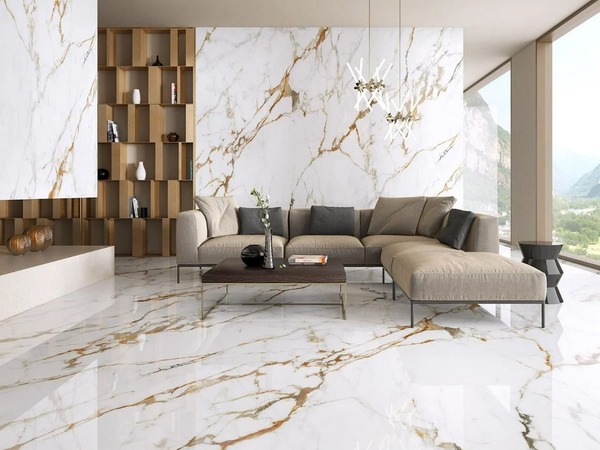Marble and Marblite are among the natural materials widely used in the construction and interior and exterior decoration industries. These stones enjoy great popularity due to their beauty, variety of colors and patterns, and unique technical properties. This article will examine the characteristics, types, applications, and important points regarding marble and marblite.
1. Definition of Marble and Marblite
1.1. Marble
Marble is a type of limestone that has transformed into a crystalline structure due to changes in temperature and pressure within the Earth. This type of stone is highly favored for decorative purposes due to its beauty and unique texture, making it easy to use in various construction projects.
1.2. Marblite
Marblite is also a type of metamorphic stone derived from limestone and usually has a softer texture and more affordable price compared to marble. Marblite is often used in interior construction and decoration, especially for flooring and wall coverings, due to its high cut and polish capability.
2. Characteristics of Marble and Marblite
2.1. Beauty and Variety
One of the outstanding features of marble and marblite is their beauty and high diversity. These stones come in various colors and designs that can match different tastes. Marble is often characterized by unique veins and patterns that enhance its aesthetic appeal.
2.2. Durability and Strength
Marble and marblite have high durability and strength due to their crystalline structure. However, marble, being softer than marblite, is slightly more susceptible to scratches and impacts.
2.3. Cutting and Polishing Capability
Both types of stone are easily cut and polished, allowing users to shape the stone into specific forms and sizes according to their requirements.
3. Applications of Marble and Marblite
3.1. Interior Decoration
Due to their beauty and light-reflective properties, marble and marblite are highly popular in interior decorations. These stones are used in the production of flooring, wall coverings, stairs, and even fireplace surrounds.
In addition, they can be used in countertops, sinks, and other architectural elements where aesthetic appeal and functionality are desired.
3.2. Outdoor Spaces
Marble and marblite are also used in the exterior facades of buildings. These stones are resistant to weather conditions, making them suitable options for building façades, landscaping, and enclosure walls.
3.3. Kitchen and Bathroom Surfaces
One of the most popular applications of marble and marblite is in the construction of countertops and sinks for kitchens and bathrooms. These stones not only provide aesthetic beauty but are also easy to clean, adding elegance and refinement to kitchen and bathroom spaces.
3.4. Sculpture and Artistic Works
Due to their natural colors and patterns, marble is utilized in the sculpture and artistic crafts industry. Artists create beautiful and unique works of art using this stone.
4. Advantages and Disadvantages
4.1. Advantages
- High Aesthetic Appeal: Provides a luxurious and stylish appearance to spaces.
- Durability and Strength: High resistance to pressure and impacts.
- Variety: Available in different colors and patterns.
- Polishing Capability: Allows for the easy application of smooth and shiny surfaces.
4.2. Disadvantages
While marble and marblite offer numerous benefits, they also have some drawbacks, including:
- Cost: The price of quality marble can be high, making it less accessible for some projects.
- Susceptibility to Stains: Marble, particularly, can be prone to staining from acidic substances, requiring careful maintenance.
- Weight: These stones are heavy, which may necessitate additional structural support in construction.
- Scratching: Marble is softer than some other stones, making it more vulnerable to scratching and wear over time.
Overall, marble and marblite are versatile materials that provide a balance of beauty and functionality, making them ideal choices for various applications in both interior and exterior design. With proper care and consideration, their advantages can significantly enhance the aesthetic and practical qualities of a space.
4.2. Disadvantages (Continued)
Scratching Sensitivity: Marble, being softer, is more prone to scratches and impacts compared to marblite. Therefore, it may sustain damage more quickly in high-traffic areas.
Stain Absorption: Due to their porous structure, both marble and marblite can easily absorb stains. This is particularly evident if food or colored liquids spill on their surfaces, necessitating more maintenance and cleaning.
Cost: The price of marble is usually higher than that of marblite. As a result, using marble in projects with a limited budget may not be economical.
Sensitivity to Chemicals: Certain chemicals, such as acids and strong cleaners, can damage the surfaces of marble and marblite, causing discoloration or dullness. Hence, using mild and non-acidic cleaners is recommended.
Need for Regular Maintenance: To maintain the beauty and functionality of marble and marblite, regular maintenance is required. This includes cleaning, preventing damage from stains, and using protective treatments.
5. Important Tips for Selection and Maintenance
5.1. Appropriate Selection
When choosing between marble and marblite, consider the needs and characteristics of the project. If you are looking for beauty and luxury, marble is a good choice. However, if you have a limited budget and require high durability, marblite may be more suitable.
5.2. Ideal Maintenance
To care for marble and marblite, several actions should be taken:
Regular Cleaning: Periodically wash surfaces with warm water and mild detergents to prevent dust and stains from accumulating.
Use Special Products: Employ stone-specific cleaning products for cleaning and maintenance. Avoid strong and acidic chemicals.
Protective Coating: Applying protective coatings can help prevent the absorption of stains and other damage.
6. Conclusion
Marble and marblite are popular choices in the construction and decoration industries due to their unique characteristics. By understanding the features, advantages, and disadvantages of these stones, they can serve as high-quality and beautiful materials for various projects. The choice between marble and marblite should be made based on the specific needs and conditions of the project, and by adhering to maintenance tips, one can enjoy the beauty and durability of these stones. Ultimately, seeking advice from professionals during the selection and installation of stones is recommended to avoid mistakes and ensure the final quality of the project.
4.2. Disadvantages (Continued)
Scratching Sensitivity: Marble, being softer, is more prone to scratches and impacts compared to marblite. Therefore, it may sustain damage more quickly in high-traffic areas.
Stain Absorption: Due to their porous structure, both marble and marblite can easily absorb stains. This is particularly evident if food or colored liquids spill on their surfaces, necessitating more maintenance and cleaning.
Cost: The price of marble is usually higher than that of marblite. As a result, using marble in projects with a limited budget may not be economical.
Sensitivity to Chemicals: Certain chemicals, such as acids and strong cleaners, can damage the surfaces of marble and marblite, causing discoloration or dullness. Hence, using mild and non-acidic cleaners is recommended.
Need for Regular Maintenance: To maintain the beauty and functionality of marble and marblite, regular maintenance is required. This includes cleaning, preventing damage from stains, and using protective treatments.
5. Important Tips for Selection and Maintenance
5.1. Appropriate Selection
When choosing between marble and marblite, consider the needs and characteristics of the project. If you are looking for beauty and luxury, marble is a good choice. However, if you have a limited budget and require high durability, marblite may be more suitable.
5.2. Ideal Maintenance
To care for marble and marblite, several actions should be taken:
Regular Cleaning: Periodically wash surfaces with warm water and mild detergents to prevent dust and stains from accumulating.
Use Special Products: Employ stone-specific cleaning products for cleaning and maintenance. Avoid strong and acidic chemicals.
Protective Coating: Applying protective coatings can help prevent the absorption of stains and other damage.
6. Conclusion
Marble and marblite are popular choices in the construction and decoration industries due to their unique characteristics. By understanding the features, advantages, and disadvantages of these stones, they can serve as high-quality and beautiful materials for various projects. The choice between marble and marblite should be made based on the specific needs and conditions of the project, and by adhering to maintenance tips, one can enjoy the beauty and durability of these stones. Ultimately, seeking advice from professionals during the selection and installation of stones is recommended to avoid mistakes and ensure the final quality of the project.



